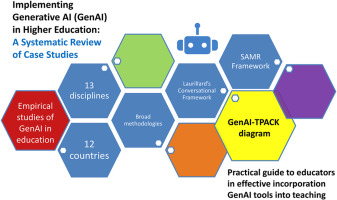The integration of Generative Artificial Intelligence (GenAI) tools, such as ChatGPT, into higher education represents a paradigm shift that not only enhances teaching methodologies but also transforms student support systems. The influx of these tools into academic settings necessitates a critical examination of their practical applications and effectiveness. While existing literature has explored theoretical frameworks around GenAI, few studies delve into empirical case studies demonstrating its actual implementation in classrooms. This article aims to bridge that gap by analyzing 21 selected empirical studies, providing insights into how GenAI can be effectively incorporated into educational practices.
The relevance of a structured approach becomes clear when investigating the integration of GenAI tools within a diverse educational landscape. The studies examined span various disciplines, geographical locations, and participant demographics—ranging from first-year students to seasoned academics. This diversity showcases the adaptability of GenAI across different educational contexts. However, we can draw insights from established frameworks such as Laurillard’s Conversational Framework (LCF) and the Substitution, Augmentation, Modification, and Redefinition (SAMR) model to categorize the use of these tools.
The LCF emphasizes the interaction between teachers and students, advocating for a dialogue-driven approach to learning. GenAI tools can augment this interaction by facilitating real-time feedback, enabling personalized pathways for knowledge acquisition, and fostering collaborative learning. In contrast, the SAMR model functions as a descriptive lens that helps evaluate how technology is integrated into education, ranging from simple tool substitution to transformative learning experiences. This analytical dichotomy contributes to a nuanced understanding of how GenAI can not only supplement but redefine educational practices.
In synthesizing definitions and recent research on Technological Pedagogical Content Knowledge (TPACK) in the context of GenAI, we uncover several critical factors contributing to effective implementation. TPACK framework emphasizes the interplay between content knowledge, pedagogical approaches, and technology. Understanding how these intersect in the age of GenAI is vital for educators looking to harness these tools’ full potential. Studies suggest that educators who are well-versed in TPACK are more likely to implement GenAI effectively and responsibly, resulting in improved student engagement and learning outcomes.
Despite its transformative potential, the integration of GenAI into higher education does not come without challenges. One major concern involves the cost implications of deploying these technologies at scale. While tools like OpenAI and Anthropic are prominent players in the GenAI landscape, they vary significantly in terms of features, pricing, and return on investment (ROI). OpenAI tends to provide more extensive language models and offers a broader range of functionalities, but this can come at a premium cost. On the other hand, Anthropic emphasizes responsible AI and safety, which may appeal to institutions prioritizing ethical considerations, yet it might lack the comprehensive toolkit of its counterpart.
A comparative analysis of these platforms reveals distinct strengths and weaknesses that can influence a leader’s decision-making. For smaller and mid-sized educational institutions, the upfront costs associated with high-performance AI models could be prohibitive. However, considering the potential for ROI through enhanced student performance and teacher productivity, the initial investment may yield significant dividends in the long term. In this light, institutions should also assess the scalability of these platforms. Tools like Make and Zapier have gained traction for automating administrative tasks in educational contexts, yet their effectiveness largely depends on the institution’s existing digital infrastructure and how seamlessly these platforms can integrate with current systems.
To provide actionable recommendations for educators and institutional leaders, a careful examination of goals, technological readiness, and resource allocation is essential. Institutions should prioritize training programs that enhance educators’ understanding of TPACK while simultaneously encouraging a culture of innovation that embraces GenAI as a tool for pedagogical enhancement. Moreover, crafting strategic partnerships with GenAI firms may offer more favorable pricing structures, thus making technology more accessible for smaller institutions.
Additionally, conducting ongoing evaluations of GenAI implementations will be critical for continuous improvement and to ensure that these technologies are being used ethically and effectively. By establishing clear metrics for assessing the impact of these tools on student outcomes, institutions can adapt quickly and make data-driven decisions that lead to better educational experiences.
In conclusion, the systematic examination of GenAI integration into higher education reveals that while the tools hold significant promise for transforming teaching and learning, careful consideration of factors like cost, scalability, and pedagogical effectiveness is essential. The GenAI-TPACK diagram presented serves as a resource to guide educators in incorporating these tools responsibly, ensuring that their deployment aligns with educational goals. This thoughtful approach will not only enhance the learning environment but also prepare institutions to navigate the evolving educational landscape.
FlowMind AI Insight: The intersection of AI and education presents a unique opportunity for institutional leaders to redefine learning environments. By leveraging data and ongoing evaluations, leaders can ensure that GenAI tools are utilized to their fullest potential, fostering both innovation and educational excellence.
Original article: Read here
2025-04-11 12:32:00

